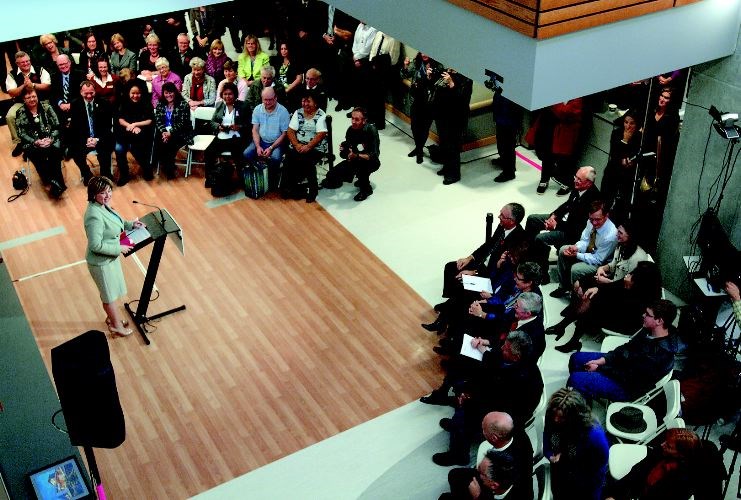Northern B.C.'s cancer centre opened on Monday. The first patient will be seen on Nov. 3.
During the grand opening ceremonies, local MLAs Pat Bell and Shirley Bond said they could both remember the day the infant cancer centre idea finally got to its feet. It was in the late fall of 2004. Bond had just been named the provinces Minister of Health. She and Bell were together for a meeting with two local doctors for a presentation led by Dr. Michelle Suter.
"The spark that started the fuse," is how Bell characterized that meeting. "She built an incredibly compelling case and when she and her colleague left the room, we felt compelled."
Suter and her colleagues were the first anecdotally quantify what the entire medical community had been sensing. Northern cancer was a broad topic, but breast cancer in particular was a beacon Suter shone into the government's eyes that day.
"I was doing an abnormally high number of mastectomies," she said. "And it wasn't for medical reasons."
Women with breast cancer had treatment choices, the most extreme being breast removal surgery, but that was the one being selected because it could be done in the North. The patients were putting that high value - invasive, permanent, life-altering surgery - on not having to go far south and spend inordinate amounts of time doing radiation therapy cut off from family, career, support systems.
Bond and Bell took this emotionally charged fact to Victoria and began a new process. It was no longer a populist wish to have a cancer centre in the North, it was a request from the medical community based on frontline evidence. (Academic confirmation has now been done led by Prince George researcher and radiation oncologist Dr. Rob Olson.)
Bond had a tough time presenting a winning case to cabinet and provincial partners like the BC Cancer Agency despite her new posting.
"I think the most difficult period was when I was the health minister. It was ironic," she said. "People who had been waiting for this a long time told me, that now that I was the minister I should just do it. I couldn't simply say 'let's just build it'. There is still a business case that had to be built, and once that was done, we could go forward. You need a certain population base, typically, for a cancer centre to have the kind of case load that specialists and technicians require. The question was, was there enough population being served? Could we demonstrate the need for radiation therapy in particular?"
Nobody in the province denied that the people of the North deserved equal cancer care as those elsewhere in the province. There were no opponents to the principle of a Prince George-based cancer centre. The only demand from cabinet, treasury board, the BC Cancer Agency, and many other stakeholders was that the body of evidence be properly documented so the decision would be transparent and undeniable.
"We were absolutely wracking our brains about how to do it, because everybody south of Williams Lake was telling us it couldn't be done," said Bell. "We [he and Bond] looked at each other and at the same time said 'Charles Jago' because he had the respect of absolutely every British Columbian. The fuse Michelle Suter lit may have gotten snuffed out were it not for Charles Jago."
The former president of UNBC, now the chair of the Northern Health Authority, worked with people like past NHA chair Jeff Burghardt, this region's Provincial Health Services Authority director Murray Sadler, and many others to canvass the North, obtaining data from doctors, surveys from medical facilities, testimony from patients and surviving families, potential funders and partners, and examining the possible bridges between the affected ministries and agencies.
A study team also went to Ontario to examine how a regional-rural cancer centre there was managing to service a scattered population.
The results ultimately impressed the full range of stakeholders, so the go-ahead was given to build the cancer centre. That was in 2009. Construction began in 2010. It was announced Monday at the official ribbon cutting that it was completed on time and under budget at $91.5 million.
That was followed by the second required effort: recruiting the people who would work at the centre. Some of the positions would require internationally-renowned scientific credentials. Part of the reasoning behind Jago's and Burghardt's detailed study was to build a campaign to attract such talented specialists.
"That was my biggest concern all along. It was unfounded," said Bond. "They just kept saying yes," when potential candidates saw the case for working in Prince George. All 82 positions were filled months ahead of schedule.
This is the BC Cancer Agency's sixth cancer centre in B.C. It is expected to service about 750 patients per year, and support the work of the region's hospitals and small cancer clinics. It will also be a player in the public campaign to pick lifestyle choices that will reduce the incidents of cancer. According to provincial data, more than half of cancer's varieties are preventable.



